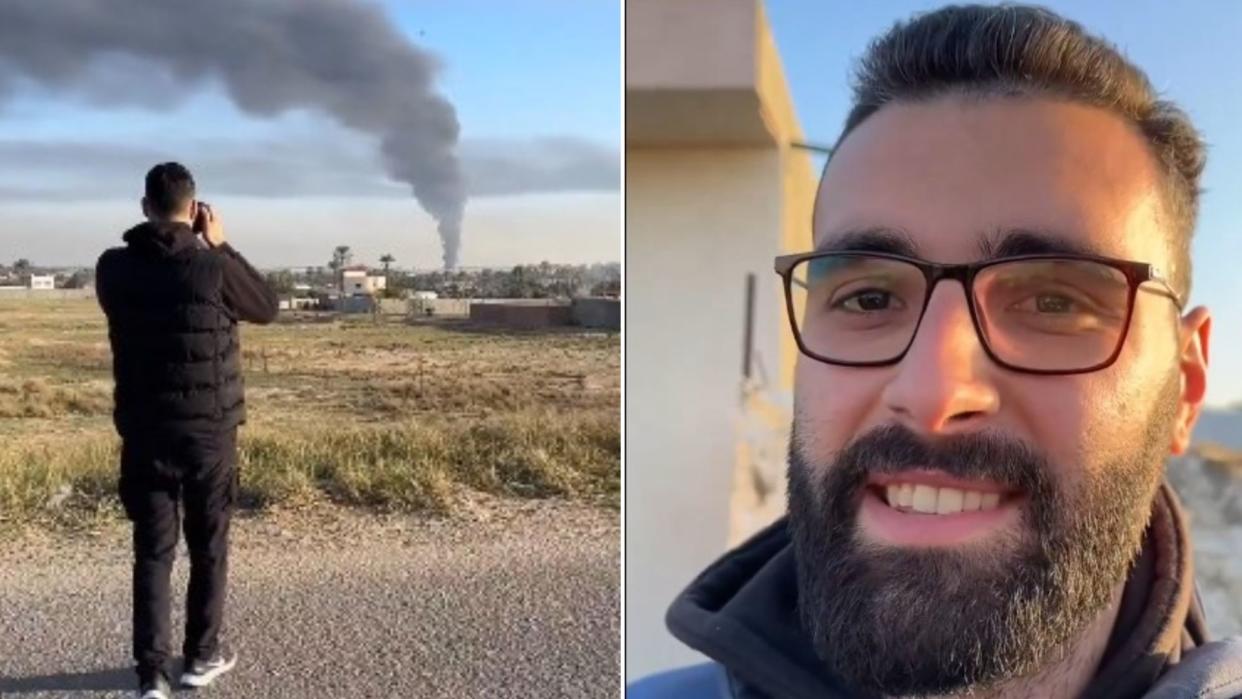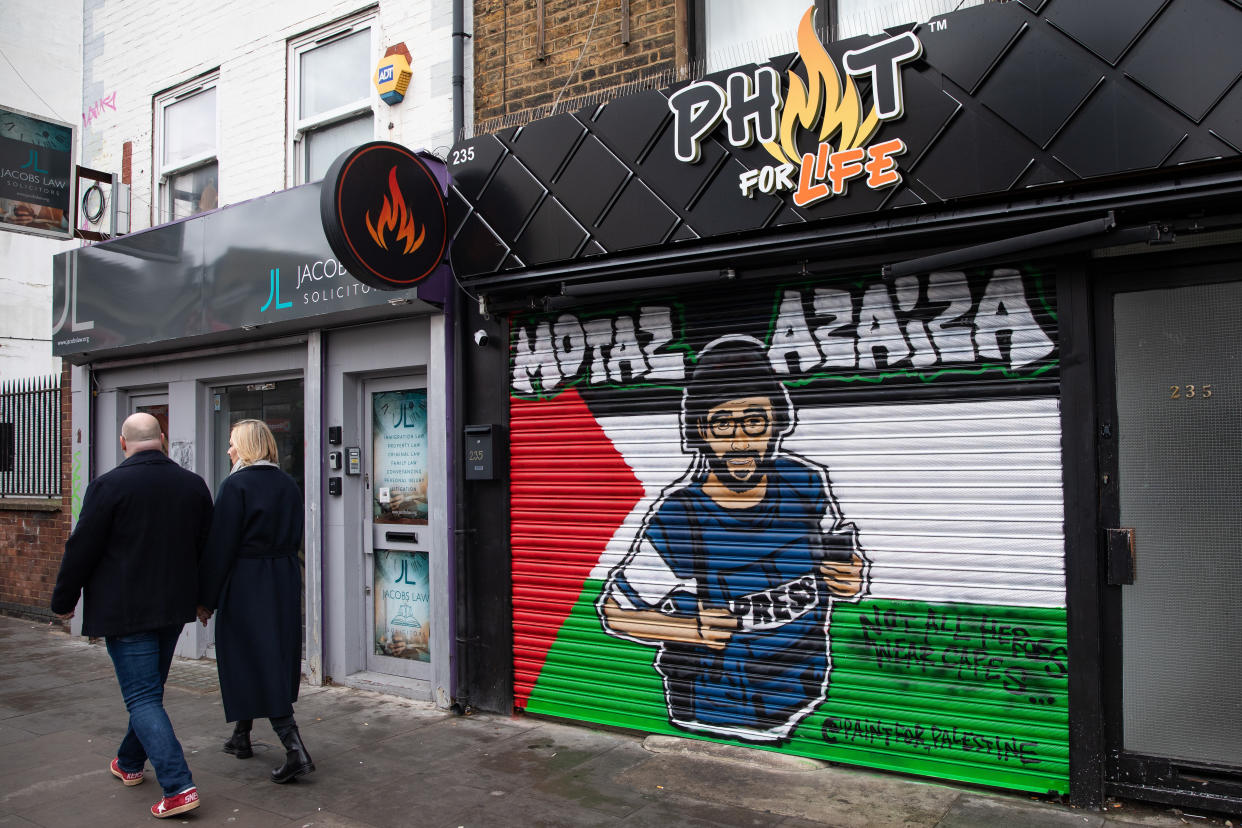Highly acclaimed photojournalist Motaz Azaiza evacuated from Gaza

The prominent Palestinian photojournalist Motaz Azaiza has said he has had to evacuate Gaza after spending 108 days documenting the war in his homeland.
Azaiza has attracted international praise for his work in the besieged Palestinian enclave – working in a conflict zone that has seen dozens of journalists lose their lives. He has previously expressed fears for his own safety, and has reportedly lost 15 members of his family since the war began on 7 October.
In an emotional video on social media, he said: “This is the last time you will see me with this heavy, stinky [press] vest. I decided to evacuate today... I'm sorry, but inshallah, hopefully soon I’ll jump back and help to build Gaza again.”
He is then shown saying "I'll miss you guys" as his colleagues help him take his press vest off. Azaiza who has travelled to Qatar, wrote in a caption: "I had to evacuate for a lot of reasons you all know some of it but not all of it."
In a video on his Instagram story, Azaiza showed he had been given a ride on a Qatari military aircraft, revealing that it was his first time travelling on any kind of aeroplane.
So,
I had to evacuate for a lot of reasons you all know some of it but not all of it.
Thank you all
Pray for Gaza. pic.twitter.com/sIqULe9d5V— MoTaz (@azaizamotaz9) January 23, 2024
Recommended reading
Press freedom groups urge Biden to hold Israel accountable for killings of journalists (The Guardian)
Al Jazeera says two Gaza journalists killed in Israeli strike (AFP)
Israel suffers biggest soldier loss as criticism of war mounts at home (Euronews)
Israel-Gaza war: what is the two-state solution and is it possible? (The Guardian)
Azaiza's departure was met with an outpouring of tributes for risking his life covering a conflict reported to have killed 25,000 Palestinians in Gaza, since Israel launched its assault in response to a surprise attack by Hamas that killed 1,200.
American journalist Yashar Ali said: "In recent months, Motaz's Instagram following has surged from around 20,000 before October 7 to 18.2 million.
"His footage has been crucial, particularly his coverage of the aftermath of Israeli air strikes. It's important to note that no external press can enter Gaza independently. Without Motaz and his colleagues, the outside world would lack footage and understanding of the events in Gaza."
Azaiza, who works as Gaza content producer for the United Nations Relief and Works Agency for Palestine Refugees (UNRWA), became a figure of inspiration across the world as many of his posts on social media went viral. A mural showing the 24-year-old Palestinian, spray painted on a wall in Manchester, was described by its creator as a tribute to "all journalists reporting from Gaza," the BBC reported.
In November, GQ Middle East named Azaiza as its 2023 "Man of the Year". The magazine said: "His work personifies the power of digital activism, and his humanity is an important reminder that bravery appears in many forms. Sometimes we choose it, other times it chooses us, and in the case of Azaiza, choice wasn’t even an option."
While Azaiza has sought to paint the grim reality of life for people in Gaza, including photos of wounded children screaming in hospital, and people sifting through the rubble of their decimated neighbourhoods, the photographer has also shown the Palestinian enclave outside the lens of conflict. He told the New Arab: "It was a paradise, now it is hell. I desperately dream of the days before, when I documented my people and my land. That's all I can think about at the moment."
"I miss taking photographs of children playing on the swings, the elderly smiling, families gathering, the sights of nature and the sea, my beautiful Gaza. I miss all of that, and it pains me to remember it."
'Family under threat'
Azaiza's coverage in Gaza has come with considerable risks. In a social media post in December, he wrote: “The phase of risking my life to show the world what’s happening is now over. A new phase has begun — the phase to survive."
"All this pressure on my mental health will make me pay a lot in the future," he also wrote. In a video in October, showing him carrying a wounded child, he said: “I don’t feel like I’m going to make it to the end, so please forgive me."
Azaiza has lost several friends and family members along the way. In an emotional post on 12 October, showing rubble of destroyed buildings, he wrote: "A new massacre but this time it’s to my family. More than 15 persons of my family got murdered by an Israeli air strike."

How many journalists have been killed?
According to the New York-based, non-profit organisation the Committee to Protect Journalists (CPJ), at least 83 journalists and media workers have been killed since the war began.
Among these, it says 76 were Palestinian, four Israeli, and three Lebanese. The CPJ added that 16 journalists were reported injured, three were reported missing, and 25 were reported arrested. It also referred to "multiple assaults, threats, cyberattacks, censorship, and killings of family members".
The CPJ said it is investigating "numerous unconfirmed reports of other journalists being killed, missing, detained, hurt, or threatened, and of damage to media offices and journalists’ homes". Many accounts of journalists being arrested and threatened have come from the West Bank.


